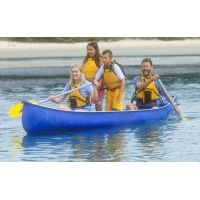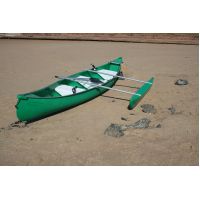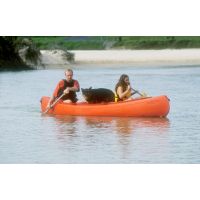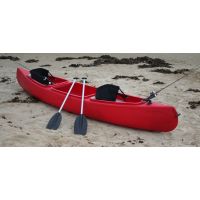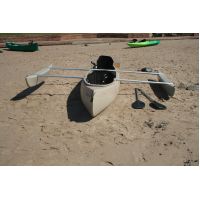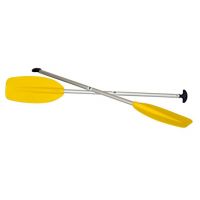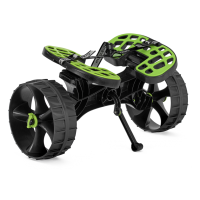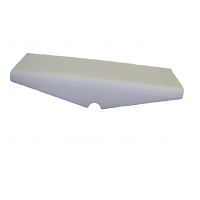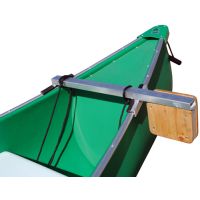Cart is empty
General Questions
We are often asked questions about paddling in general and about Australis products in particular. If you have a question that has not been answered in these pages, please contact Australis on 02 4285 2000.
To make it easy to find what you are looking for, questions and answers relating to products are listed below:
AUSTRALIS LIFETIME WARRANTY
What does it mean to have a Lifetime Warranty?
All watercraft manufactured by Australis Canoes & Kayaks are covered by a Lifetime Warranty.
- The Lifetime Warranty offered by Australis Canoes covers faulty materials and workmanship.
- It applies to watercraft used for domestic purposes and does not apply to commercial operators.
- Warranty does not cover misuse, carelessness, lack of maintenance or general wear and tear caused by usage.
Damage caused by wear and tear can usually be repaired, even though it is not covered by warranty.
Spare parts are also readily available because all Australis watercraft are manufactured in Wollongong.
PRODUCT OF AUSTRALIA
Why do you use the "Product of Australia" logo?
Australis is proud to be a licensee of the Australian Made, Australian Grown campaign. This logo assists customers in identifying products made in Australia so they can make informed decisions about purchasing products that support manufacturing and jobs in Australia.
All Australis canoes, kayaks, sea kayaks, sit-on-tops and paddles have been certified as a "Product of Australia" which is the highest qualification offered to a manufacturer. This means that all of our manufacturing processes occur within Australia, using Australian raw materials (whenever possible). In this way we support many other small businesses who employ Australian workers.
In addition, our products have been designed in Australia for Australian paddling conditions, and are not foreign products made under licence.
We feel this certification will help consumers identify between products that have been manufactured in Australia, and products that are sold by companies who say they are "Australian owned and operated" but who actually sell products that have been manufactured overseas.
Why don't you use the "Australian Made" logo?
Australis kayaks, canoes, sit-on-tops and paddles all qualify to display the "Australian Made and Owned" logo but Australis usually uses the "Product of Australia" logo as it s the highest qualification offered to a manufacturer. This means that all of our manufacturing processes occur within Australia, using Australian raw materials (whenever possible). In this way we support many other small businesses who employ Australian workers.
Many companies in the canoeing and kayaking industry are Australian owned but the products they sell are not manufactured here. These companies OMIT to say that their products are made overseas, and hope the consumer will assume that because the company is "Australian" that the product is also "Australian".
Other companies actually construct overseas products here in Australia under licence to a foreign company or the parts are shipped out to be assembled here. While these may be technically "Made in Australia" most of the work is done overseas and the profits from these products go back to the overseas parent company. Purchasing these products does not support the Australian economy in the same way that a "Product of Australia" does.
All Australis products are:
- 100% Australian Made
- 100% Australian Designed, and
- Australis is a 100% Australian Owned Family Company
A combination of these 3 factors ensures that we are supporting Australian jobs, Australian manufacturing and the Australian economy. As a bonus you, the customer, receives a craft that has been designed specifically for Australian conditions. You are not only receiving a product that is "Australian Made" but one that is also a "Product of Australia". We use the "Product of Australia" logo because it is the highest classification available to manufacturers.
By buying a "Product of Australia" you are receiving a product of the highest quality and supporting all the businesses across Australia who supply Australis with the hundreds of small parts that go into the manufacture and assembly of our canoes and kayaks. You are helping these businesses compete with big, overseas companies and you are supporting manufacturing and jobs in Australia. And as a added bonus all the profits remain in local Australian communities.
To find out why buying Australian is good for you, for your family & friends and for Australia go to the Australian Made website.
DIFFERENCES
What is the difference between Plastic and Fibreglass?
The most basic differences are:
Plastic:
- Rotational moulded products are made as 1 piece and there are no seams that can split.
- Very durable and resistant to impact, such as running into rocks or dropping onto the ground
- You will not experience any irritation from contact with the plastic, and because they made by melting grindings together, there are no loose ends to get tangled in your clothes or skin.
- Is generally a little bit heavier.
Fibreglass:
- Generally made in 2 halves (a top and a bottom), and then joined.
- If you run into a rock, is more likely to be damaged and require repair.
- Some people have been known to get itchy from touching fibreglass and if the small fibres penetrate the skin, they can cause an infection.
- Depending on the manufacturer, a boat of the same size will usually be a little bit lighter, but can also be heavier.
What is the difference between a canoe and kayak?
The most basic differences are:
Canoe:
- In a canoe you sit on a raised seat with your legs bent to 90 degrees (like you do when you sit in a chair).
- In a canoe you will usually use single paddles (although you can use a double paddle, but it will need to be longer than standard to give you the extra reach down to the water because you are sitting up higher than you would be in a kayak).
- In a canoe you can generally take a lot more bulky gear than in a kayak. Most canoes will be able to easily take the hard plastic 30 and 60 litre storage drums.
Kayak:
- In a kayak you sit on a seat on the bottom of the hull with your legs straight out in front.
- In a kayak you will usually use double paddles (although you can use singles if required).
- In a kayak there is usually less storage space and because you have to get any gear to be stored into the kayak, you can only take smaller items and they will need to be able to fit into dry bags.
What do I need to consider when choosing between a sit-in and a sit-on kayak?
There are a number of differences between a sit-in and a sit-on kayak, and these are:
Sit-in Kayak:
- In a sit-in kayak you will stay drier and warmer, making it more enjoyable to paddle in winter, and meaning that you can use your kayak all year round.
- With a sit-in kayak, you will need to be able to lower and lift yourself into and out of the kayak in a forward facing position, so some co-ordination and physical strength will be required.
- Whilst a sit-in kayak gives you the advantage of being able to stay drier, they also have the possibility of being able to be filled with water. Whilst Australis watercraft will float above the waterline full of water, the weight of the water will mean that they will become heavy and will make it difficult when you have to swim it to shore to empty it out.
Tip: To get rid of water in your kayak when out on the water, carry a bailer/bucket or hand bilge pump so that you can scoop most of the water out. A sponge is great for getting rid of those last little bits of water.
Sit-on-Top Kayak:
- On a sit-on kayak you are more likely to get wet (even with plugs blocking the drainage holes) meaning that you are more likely to get cold if you paddle through winter.
- A sit-on kayak is easier to get onto for people with reduced physical capacities. For those with arthritic or range of motion issues (who will benefit from the general exercise of paddling), a sit-on kayak will allow you to sit side-on to the kayak and then to swing your legs around and into the forward facing position.
- Sit-on kayaks are great for children and teenagers because they can climb onto the kayak from the water, and any water they bring over the edge as they climb back in, will drain straight out of the drainage holes, meaning that they can't fill the kayak up with water.
What are the differences between a wave ski and a sit-on-top kayak?
Wave Ski:
- Has fins underneath and also has footstraps and a seatbelt
- Is designed to ride waves but is not suitable for distance paddling
- As a wave ski is a lower volume craft, it starts deeper in the water and requires more effort to get up on top of the water
- Are usually designed for lighter people
Ocky, Foxx & Squid Sit-on-Top Kayaks:
- Do not have fins, footstraps or seatbelts
- Are much better for distance paddling and can ride waves (but not as well as a wave ski).
- The Ocky, Foxx and Squid are much more like all-rounders but not all brands of sit-on-tops are made to perform this way
- Because of the larger volume they sit higher in the water and require less effort to paddle
- Are designed to take more capacity (110kg for Ocky, 130kg for Foxx & Squid) than wave skis.
COLOURS
Questions regarding the colour options for Australis canoes and kayaks
REPAIRS & MAINTENANCE
Can my craft be welded if I get a hole in it?
All Australis products are made from first use, high density, linear polyethylene.
This material is repairable, and can easily be welded by anyone experienced in plastic welding.
Welding rod repair kits can be purchased from Australis Canoes in colours to match your Australis watercraft.
Can I buy replacement parts for my kayak or canoe?
Repacement parts are always available because all Australis canoes, kayaks and sit-on-tops are manuafcatured and assembled at our factory in Bellambi, near Wollongong. These parts are designed specifically for Australis watercraft but many, such as the outriggers and hatches, can also be used on other brands.
What do I need to do to maintain my canoe?
NOT MUCH!!
Australis Canoes are virtually maintenance free, which is one of the reasons why they are so popular with hire operators.
The use of aluminium supports and plastic moulded seats means that there is no wood that can rot over time because of exposure to the elements.
All you need do (if you really want to), is to hose any sand or mud out of the boat.
What do I need to do to maintain my kayak with a rudder?
We recommend that you hose off your rudder cables and footrests if you have been in sandy or salty conditions to minimise salt build up on these parts, that can make it difficult to adjust for another person.
Beore each extended journey or open ocean paddle, check that all of your cables are in good condition and not frayed or close to breaking. It is also a good idea to carry spare cable in your kayak incase one of your cables breaks.
© 2013-2025 Australis Canoes. Powered by AVS Online Store

